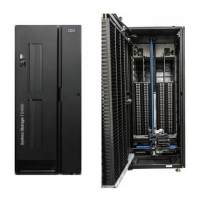storage unit that will become the primary. That is, production will failover to Site B
during this outage, which will make the target volumes at Site B convert to source
volumes and cause them to suspend. Your original source volumes at Site A remain
in the state they were in at the time of the site switch. See Table 3 for an example
of the implementation of failover and failback operations.
Note: The failover recovery operation does not reverse the direction of a remote
mirror and copy pair. It will change a target volume into a suspended source
volume, while leaving the source volume in its current state.
The following assumptions are made for this scenario:
v Applications are updating the source volumes located at Site A.
v Paths are established from Site A to Site B.
v Volume pairs are in duplex state.
Perform
the following steps using the DS Storage Manager. You can also use the
DS CLI to perform Copy Services functions.
1. When the planned outage window is reached, quiesce applications to cease all
write I/O from updating the source volumes. Quiescing your applications should
occur as part of a planned outage and the outage should be brief. Depending
on the host operating system, it might be necessary to unmount the source
volumes.
2. Perform a failover recovery operation to Site B. After the failover operation has
processed successfully, the volumes at Site B transition from target to source
volumes.
3. Depending on your path design and when the source storage unit becomes
available, create paths in the opposite direction from Site B to Site A. You will
need the paths in the opposite direction if you want to transfer the updates back
to Site A.
4. Depending on your operating system, it might be necessary to rescan your
fibre-channel connected devices (to remove device objects for the site A
volumes and recognize the new source volumes).
5. Mount your target volumes (now the new source volumes) on the target storage
unit at Site B.
6. Start all applications. After the applications start, all write I/O operations to the
source volumes are tracked. Depending on your plans regarding Site A, the
volume pairs can remain suspended (if you want to do offline maintenance).
7. When your scheduled maintenance is complete, schedule a time for a failback
recovery operation to initiate the transfer of data back to Site A. This process
resynchronizes the volumes at Site A with the volumes at Site B.
Note: Failback recovery operations are usually used after a failover recovery
has been issued to restart mirroring either in the reverse direction
(remote site to local site) or original direction (local site to remote site).
Table 3. Failover and failback implementation
Step Operation
Manage-
ment
required
to
Format of
source
volume and
target
volume
Format of
source and
target volume
pair Result: Site A Result: Site B
1
142 DS8000 User’s Guide
|
|
|
|
|
|
|
|
|
|
|
|
|
|
|
|
|
|
|
|
|
|
|
|
|
|
|
|
|
|
|
|
|
|
|
|
|
|
|
|
|
|
||
|
|
|
|
|
|
|
|
|
|
|
|
|||
|

